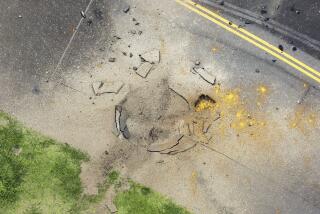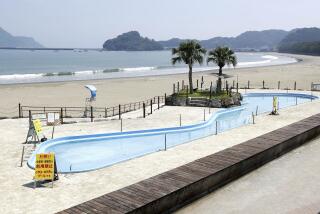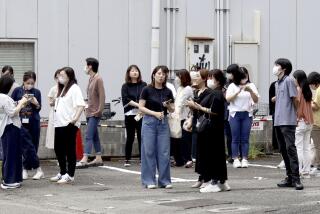Aftershocks and nuclear threat keep Japanâs residents in fear
Reporting from Utsunomiya, Japan and Los Angeles â Aftershocks continued to jolt Japan as rescue efforts increased Sunday morning following Fridayâs 8.9 magnitude earthquake.
The island nation had experienced more than 275 aftershocks of magnitude 5 or greater as of Sunday morning, according to the United States Geological Survey. Of those aftershocks, 27 have been magnitude 6 or greater, USGS records show.
âAnd that could change. We have more every hour,â said Dale Grant, a geophysicist at the USGS National Earthquake Information Center in Golden, Colo.
Photos: Scenes from the earthquake
Grant said his office was observing 12 to 15 aftershocks per hour from the earthquake.
âItâs a huge quake â itâs incredible,â he said. âThe death and destruction is going to be terrible.â
Grant said the aftershocks were not surprising given the strength of the quake, the worst in Japanâs history and the fifth-largest worldwide. After such a major rupture of tectonic plates comes the requisite repositioning, creating aftershocks, Grant said.
âWhenever you have a relatively shallow event like this and the earth ruptures so abruptly, then the earth tries to come back to equilibrium,â Grant said. âThatâs what these aftershocks are doing.â
He said it was difficult to determine when the aftershocks would slow or stop.
INTERACTIVE MAP: Shaking before and after the great quake
Although the National Oceanic and Atmospheric Administration has lifted tsunami warnings across the Pacific, Japan and other areas were still seeing some sizeable waves due to the aftershocks Sunday, officials said.
âWe are still seeing sea-level fluctuations at many gauges in the Pacific region but the waves are much smaller than right after the earthquake, so we are not too worried about wave heights,â said Dailin Wang, an oceanographer with the agencyâs Pacific Tsunami Warning Center in Hawaii.
The official death toll from the quake and the tsunami that followed stood at 689 Sunday, with 639 missing, according to Japanâs National Police Agency. The police agency estimated that 1,570 people had been injured in the disaster.
Officials expect the death toll to increase in coming days as rescuers reach more coastal areas decimated by the tsunami. Japanese public broadcaster NHK has reported that more than 900 have died and Kyodo News Agency estimated that the death toll could reach 1,800.
In one coastal town alone â Minamisanriku, in Miyagi prefecture â officials said about 10,000 people, half the townâs population, were still unaccounted for Sunday, Kyodo reported.
Japanese Prime Minister Naoto Kan is expected to double the number of Self-Defense Forces personnel sent to quake-damaged areas to 100,000, Defense Minister Toshimi Kitazawa said Sunday, according to Kyodo News Agency.
Kitazawa told a meeting of the ministryâs emergency headquarters that he has received the order from Kan, Kyodo reported.
Meanwhile, Japanese government officials argued on CNN about whether a nuclear meltdown had occurred at the quake-damaged Fukushima No. 1 power plant about 150 miles north of Tokyo and 40 miles from the earthquakeâs epicenter.
âThere is a possibility, we see the possibility of a meltdown,â Toshihiro Bannai, director of the international affairs office of Japanâs Nuclear and Industrial Safety, told CNN. âAt this point, we have still not confirmed that there is an actual meltdown, but there is a possibility.â
Bannai said engineers had been unable to get close enough to the reactorâs core to determine whether there was a meltdown, but that he based his conclusion on radioactive cesium and iodine measured in the air near the plant Saturday night.
Japanâs ambassador to the United States insisted that there was no evidence of a nuclear meltdown at the plant.
âWe have confirmed that there was a blowup but it was not a blowup of reactor nor container. It was a blowup of the outer building so there was no leakage of the radioactive material,â Ambassador Ichiro Fujisaki told CNNâs Wolf Blitzer. âWe are now trying to cope with the situation by putting saltwater into the reactor. There are some other issues with other reactors as well, which need also injection of water or taking out vapor because of increasing pressure into the container and we are now working on it.â
A state of emergency has been declared for the reactor and two of the five other reactors at the plant complex, Fujisaki told CNN. Three reactors were in a safe, shut-down state, he said.
On Saturday, more than 50,000 people had been evacuated after an explosion at the plant hurled plumes of smoke over the Pacific Ocean and sent officials scrambling to calm residents already shattered by the largest earthquake in the nationâs recorded history.
Japanese authorities hastened to assure the public there was no danger of a meltdown along the lines of the 1986 disaster at the Chernobyl nuclear plant in Ukraine, but they were unable to explain why excess levels of radiation were detected outside the plantâs grounds.
Japanese Cabinet Secretary Yukio Edano said the explosion at the plant was caused by a buildup of hydrogen in the cooling system. He insisted that the explosion didnât cause any damage to the reactor itself but merely caused the collapse of a wall outside.
Japanâs NHK television reported that at least three of 90 residents randomly tested showed excess exposure to radiation. The people had apparently been exposed as they waited outside a school for evacuation by helicopter, the network said, citing local officials.
On Sunday, the Japanese Fire and Disaster Management Agency announced that 15 patients and an ambulance were exposed to radiation at a hospital within seven miles of the plant, Kyodo reported.
The International Atomic Energy Agency in Vienna said it was told by Japanese officials that they would distribute iodine tablets to residents nearby. Iodine is known to protect against thyroid cancer that can develop from radiation poisoning.
Photos: Scenes from the earthquake
âIâve gotten used to the earthquake. But this business with the radiation has me more worried,â said Eri Tamada, a 22-year-old medical student who had fled Fukushima for Utsunomiya, 50 miles away. She and a classmate had been trapped for three hours on a train when the quake struck Friday, and they spoke with slightly quavering voices, clearly rattled from their experience.
âFirst the earthquake, now the nuclear accident. Weâll never know what the future holds,â said her friend, 24-year-old Hideyuki Shimizu.
More to Read
Sign up for Essential California
The most important California stories and recommendations in your inbox every morning.
You may occasionally receive promotional content from the Los Angeles Times.











